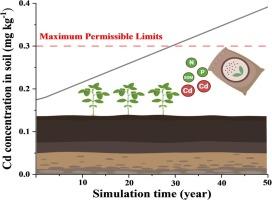Evaluating the trade-offs between nutrient and cadmium levels in soils in northeastern China: Accounting for variations in soil factors
IF 7
2区 环境科学与生态学
Q1 ENVIRONMENTAL SCIENCES
引用次数: 0
Abstract
Agricultural soils have relied on the application of fertilizers to enhance soil fertility and yields in response to increasing food demands. However, the potentially hazardous trace elements that accumulate in soils have been largely overlooked. In this study, we set out to determine the soil factor indicators in croplands using Exploratory Factor Analysis to illuminate the trade-off between surplus soil nutrients and cadmium (Cd) accumulation as a result of fertilizer application. The research in northeastern China highlights the fact that studies tend to ignore the accumulation and distribution of hazardous heavy metals in production fields in favor of an over-emphasis on soil fertility indicators; an ultimately unsustainable approach. The model showed that soil nutrient could be identified based on three soil factors: soil organic matter, soil available nutrients, and soil nutrient buffer structures. Fertilization enhanced the level of available nutrients and significantly increased both soil organic matter and available phosphorus by 0.71 % and 11 mg kg−1, respectively. However, the long-term application of phosphorus (P) leads to a P-surplus and leaves soils more susceptible to Cd accumulation. The 90th percentile estimate of soil Cd concentration was 1.4 times higher than the P-optimal level. Scenario analyses of long-term fertilizer management indicated that, over a 50-year simulation period, the impact of Cd accumulation in soils in traditional agriculture was insignificant. However, prolonged application of excess P-fertilizer would lead to a continuous increase in the concentration of accumulated Cd from 0.17 mg kg−1 to 0.40 mg kg−1. Trade-off and scenario analyses guide agricultural fertilization practices to preserve soil quality while sustaining productivity.

评估中国东北地区土壤养分和镉含量之间的权衡:考虑土壤因子的变化
农业土壤一直依赖施肥来提高土壤肥力和产量,以满足日益增长的粮食需求。然而,土壤中积累的潜在有害微量元素却在很大程度上被忽视了。在这项研究中,我们利用探索性因子分析法确定了耕地的土壤因子指标,以揭示施肥导致的土壤养分过剩与镉(Cd)积累之间的权衡关系。在中国东北地区进行的研究突出表明,研究往往忽视有害重金属在生产田中的积累和分布,而过分强调土壤肥力指标,这种做法最终是不可持续的。该模型表明,土壤养分可根据土壤有机质、土壤可利用养分和土壤养分缓冲结构这三个土壤因子进行识别。施肥提高了可利用养分的水平,并使土壤有机质和可利用磷分别显著增加了 0.71 % 和 11 mg kg-1。然而,长期施磷会导致磷过剩,使土壤更容易积累镉。土壤中镉浓度的第 90 百分位数估计值比最佳磷含量高 1.4 倍。对长期肥料管理的情景分析表明,在 50 年的模拟期内,传统农业土壤中镉积累的影响不大。然而,长期施用过量的钾肥会导致累积镉浓度从 0.17 毫克/千克-1 持续上升到 0.40 毫克/千克-1。权衡和情景分析可指导农业施肥实践,在保持生产力的同时保护土壤质量。
本文章由计算机程序翻译,如有差异,请以英文原文为准。
求助全文
约1分钟内获得全文
求助全文
来源期刊

Ecological Indicators
环境科学-环境科学
CiteScore
11.80
自引率
8.70%
发文量
1163
审稿时长
78 days
期刊介绍:
The ultimate aim of Ecological Indicators is to integrate the monitoring and assessment of ecological and environmental indicators with management practices. The journal provides a forum for the discussion of the applied scientific development and review of traditional indicator approaches as well as for theoretical, modelling and quantitative applications such as index development. Research into the following areas will be published.
• All aspects of ecological and environmental indicators and indices.
• New indicators, and new approaches and methods for indicator development, testing and use.
• Development and modelling of indices, e.g. application of indicator suites across multiple scales and resources.
• Analysis and research of resource, system- and scale-specific indicators.
• Methods for integration of social and other valuation metrics for the production of scientifically rigorous and politically-relevant assessments using indicator-based monitoring and assessment programs.
• How research indicators can be transformed into direct application for management purposes.
• Broader assessment objectives and methods, e.g. biodiversity, biological integrity, and sustainability, through the use of indicators.
• Resource-specific indicators such as landscape, agroecosystems, forests, wetlands, etc.
 求助内容:
求助内容: 应助结果提醒方式:
应助结果提醒方式:


